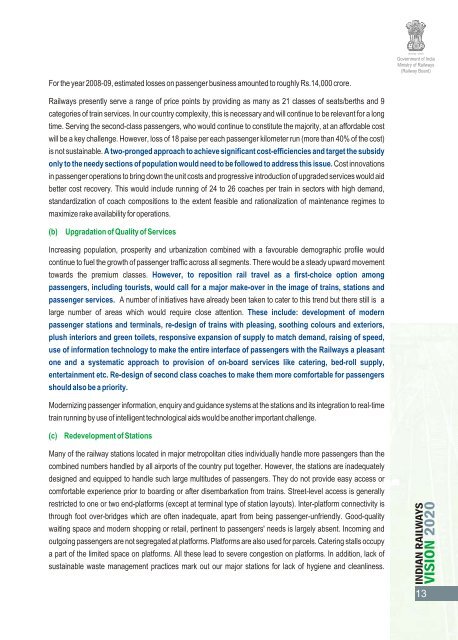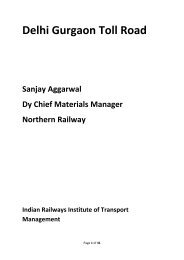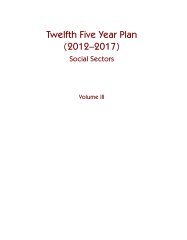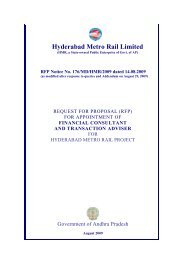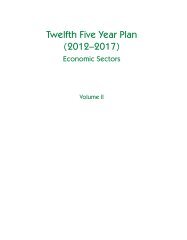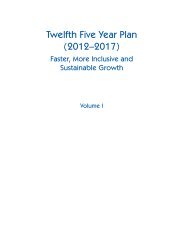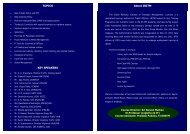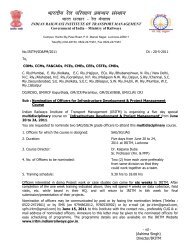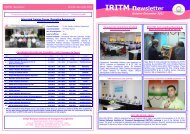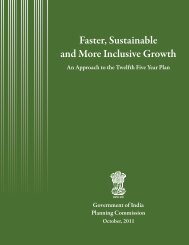Vision 2020 - Transportation Research Group of India
Vision 2020 - Transportation Research Group of India
Vision 2020 - Transportation Research Group of India
Create successful ePaper yourself
Turn your PDF publications into a flip-book with our unique Google optimized e-Paper software.
Government <strong>of</strong> <strong>India</strong><br />
Ministry <strong>of</strong> Railways<br />
(Railway Board)<br />
For the year 2008-09, estimated losses on passenger business amounted to roughly Rs.14,000 crore.<br />
Railways presently serve a range <strong>of</strong> price points by providing as many as 21 classes <strong>of</strong> seats/berths and 9<br />
categories <strong>of</strong> train services. In our country complexity, this is necessary and will continue to be relevant for a long<br />
time. Serving the second-class passengers, who would continue to constitute the majority, at an affordable cost<br />
will be a key challenge. However, loss <strong>of</strong> 18 paise per each passenger kilometer run (more than 40% <strong>of</strong> the cost)<br />
is not sustainable. A two-pronged approach to achieve significant cost-efficiencies and target the subsidy<br />
only to the needy sections <strong>of</strong> population would need to be followed to address this issue. Cost innovations<br />
in passenger operations to bring down the unit costs and progressive introduction <strong>of</strong> upgraded services would aid<br />
better cost recovery. This would include running <strong>of</strong> 24 to 26 coaches per train in sectors with high demand,<br />
standardization <strong>of</strong> coach compositions to the extent feasible and rationalization <strong>of</strong> maintenance regimes to<br />
maximize rake availability for operations.<br />
(b) Upgradation <strong>of</strong> Quality <strong>of</strong> Services<br />
Increasing population, prosperity and urbanization combined with a favourable demographic pr<strong>of</strong>ile would<br />
continue to fuel the growth <strong>of</strong> passenger traffic across all segments. There would be a steady upward movement<br />
towards the premium classes. However, to reposition rail travel as a first-choice option among<br />
passengers, including tourists, would call for a major make-over in the image <strong>of</strong> trains, stations and<br />
passenger services. A number <strong>of</strong> initiatives have already been taken to cater to this trend but there still is a<br />
large number <strong>of</strong> areas which would require close attention. These include: development <strong>of</strong> modern<br />
passenger stations and terminals, re-design <strong>of</strong> trains with pleasing, soothing colours and exteriors,<br />
plush interiors and green toilets, responsive expansion <strong>of</strong> supply to match demand, raising <strong>of</strong> speed,<br />
use <strong>of</strong> information technology to make the entire interface <strong>of</strong> passengers with the Railways a pleasant<br />
one and a systematic approach to provision <strong>of</strong> on-board services like catering, bed-roll supply,<br />
entertainment etc. Re-design <strong>of</strong> second class coaches to make them more comfortable for passengers<br />
should also be a priority.<br />
Modernizing passenger information, enquiry and guidance systems at the stations and its integration to real-time<br />
train running by use <strong>of</strong> intelligent technological aids would be another important challenge.<br />
(c)<br />
Redevelopment <strong>of</strong> Stations<br />
Many <strong>of</strong> the railway stations located in major metropolitan cities individually handle more passengers than the<br />
combined numbers handled by all airports <strong>of</strong> the country put together. However, the stations are inadequately<br />
designed and equipped to handle such large multitudes <strong>of</strong> passengers. They do not provide easy access or<br />
comfortable experience prior to boarding or after disembarkation from trains. Street-level access is generally<br />
restricted to one or two end-platforms (except at terminal type <strong>of</strong> station layouts). Inter-platform connectivity is<br />
through foot over-bridges which are <strong>of</strong>ten inadequate, apart from being passenger-unfriendly. Good-quality<br />
waiting space and modern shopping or retail, pertinent to passengers' needs is largely absent. Incoming and<br />
outgoing passengers are not segregated at platforms. Platforms are also used for parcels. Catering stalls occupy<br />
a part <strong>of</strong> the limited space on platforms. All these lead to severe congestion on platforms. In addition, lack <strong>of</strong><br />
sustainable waste management practices mark out our major stations for lack <strong>of</strong> hygiene and cleanliness.<br />
13


